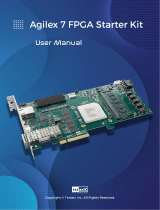
1. Design Guidelines for HDMI Intel® FPGA IP
The design guidelines help you implement the High-Definition Multimedia Interface
(HDMI) Intel FPGA IPs using FPGA devices.
These guidelines facilitate board designs for the HDMI Intel® FPGA IP video interfaces.
Related Information
•HDMI Intel FPGA IP User Guide
•AN 745: Design Guidelines for Intel FPGA DisplayPort Interface
1.1. HDMI Intel FPGA IP Design Guidelines
The HDMI Intel FPGA interface has Transition Minimized Differential Signaling (TMDS)
data and clock channels. The interface also carries a Video Electronics Standards
Association (VESA) Display Data Channel (DDC).
The TMDS channels carry video, audio, and auxiliary data. The DDC is based on I2C
protocol. The HDMI Intel FPGA IP core uses the DDC to read Extended Display
Identification Data (EDID) and exchange configuration and status information between
an HDMI source and sink.
1.2. HDMI Intel FPGA IP Board Design Tips
When you are designing your HDMI Intel FPGA IP system, consider the following board
design tips.
• Use no more than two vias per trace and avoid via stubs
• Match the differential pair impedance to the impedance of the connector and cable
assembly (100 ohm ±10%)
• Minimize inter-pair and intra-pair skew to meet the TMDS signal skew requirement
• Avoid routing a differential pair over a gap in the underneath plane
• Use standard high speed PCB design practices
• Use level shifters to meet electrical compliance at both TX and RX
• Use robust cables, such as Cat2 cable for HDMI 2.0
1.3. Schematic Diagrams
The Bitec schematic diagrams in the provided links illustrate the topology for the Intel
FPGA development boards.
Using HDMI 2.0 link topology requires you to meet the 3.3 V electrical compliance. To
meet the 3.3 V compliance on Intel FPGA devices, you need to use a level shifter. Use
a DC-coupled redriver or retimer as the level shifter for the transmitter and receiver.
683677 | 2019-01-28
Send Feedback
Intel Corporation. All rights reserved. Intel, the Intel logo, and other Intel marks are trademarks of Intel
Corporation or its subsidiaries. Intel warrants performance of its FPGA and semiconductor products to current
specifications in accordance with Intel's standard warranty, but reserves the right to make changes to any
products and services at any time without notice. Intel assumes no responsibility or liability arising out of the
application or use of any information, product, or service described herein except as expressly agreed to in
writing by Intel. Intel customers are advised to obtain the latest version of device specifications before relying
on any published information and before placing orders for products or services.
*Other names and brands may be claimed as the property of others.
ISO
9001:2015
Registered











